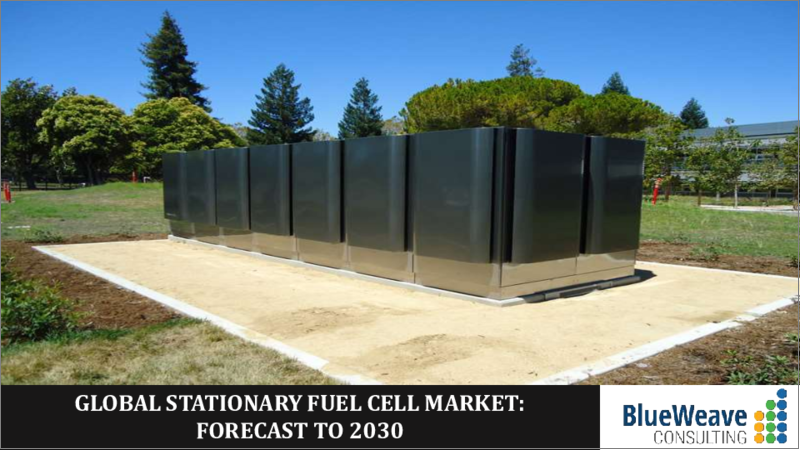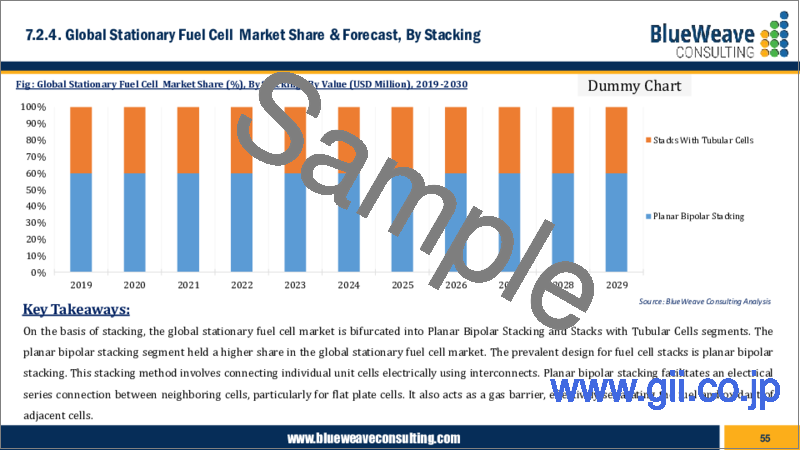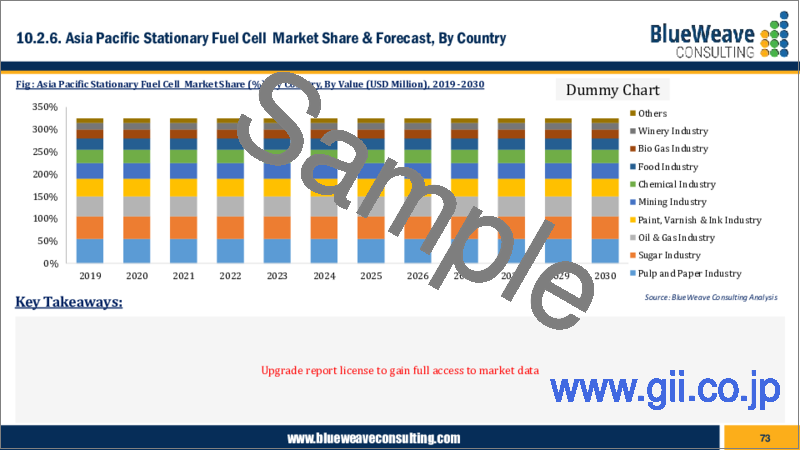|
|
市場調査レポート
商品コード
1301812
定置用燃料電池市場:世界の市場規模、シェア、動向分析、機会、予測レポート、2019-2029年Stationary Fuel Cell Market - Global Size, Share, Trend Analysis, Opportunity and Forecast Report, 2019-2029, Segmented By Type ; By Capacity ; By Application ; By Stacking ; By End Use ; By Region |
||||||
| 定置用燃料電池市場:世界の市場規模、シェア、動向分析、機会、予測レポート、2019-2029年 |
|
出版日: 2023年06月26日
発行: Blueweave Consulting
ページ情報: 英文 400 Pages
納期: 2~3営業日
|
- 全表示
- 概要
- 目次
定置用燃料電池の世界市場規模は2倍以上に拡大、2029年までに106億米ドルに達する
定置用燃料電池の世界市場は、燃焼エンジンに代わる低騒音型燃料電池への需要の高まりと、定置用燃料電池の採用拡大により活況を呈しています。
戦略コンサルティング・市場調査の大手であるBlueWeave Consultingは、最近の調査で、2022年の定置用燃料電池の世界市場規模を48億3,000万米ドルと推定しました。2023年から2029年までの予測期間中、BlueWeaveは定置用燃料電池の世界市場規模が11.93%の大幅なCAGRで成長し、2029年には105億9,000万米ドルに達すると予測しています。世界の定置用燃料電池市場の主な成長促進要因には、クリーンで効率的なエネルギーソリューションに対する需要の増加、政府の支援とインセンティブ、燃料電池技術の進歩などがあります。世界各国の政府は、定置用燃料電池市場の発展を支援することを目的として、研究イニシアティブへの投資や融資プログラムの実施を進めています。米国や欧州のような新興経済諸国は、自国の電力網を変革するための技術革新の導入に特に注力しており、予測期間中の市場成長に大きく貢献すると予想されます。しかし、定置用燃料電池のコストが高く、定置用燃料電池に関する一般市民の認識が限定的であることが、市場全体の成長を抑制すると予想されます。
本レポートの詳細な分析により、世界の定置用燃料電池市場の成長可能性、今後の動向、統計に関する情報を提供します。また、総市場規模の予測を促進する要因も明らかにしています。当レポートは、世界の定置用燃料電池市場の最新技術動向や、意思決定者が適切な戦略的意思決定を行うための業界洞察を提供することをお約束します。さらに、市場の成長促進要因・課題・競争力学についても分析しています。
目次
第1章 調査の枠組み
第2章 エグゼクティブサマリー
第3章 世界の定置用燃料電池市場に関する洞察
- 業界のバリューチェーン分析
- DROC分析
- 成長の原動力
- 定置用燃料電池の急速な普及
- 内燃機関に代わる低騒音代替品に対する需要の増加
- 抑制要因
- 定置用燃料電池は高コスト
- 定置用燃料電池に関する一般の認識が限られている
- 機会
- 従来の電池よりも燃料電池への支持が高まる
- 再生可能エネルギーの開発
- 課題
- 入手可能な燃料が限られている
- 成長の原動力
- 技術の進歩/最近の開発
- 規制の枠組み
- ポーターのファイブフォース分析
第4章 世界の定置用燃料電池市場概要
- 市場規模と予測、2019~2029年
- 金額別
- 市場シェアと予測
- タイプ別
- 固体高分子形燃料電池(PEMFC)
- リン酸形燃料電池(PAFC)
- 溶融炭酸塩形燃料電池(MCFC)
- 固体酸化物形燃料電池(SOFC)
- 直接メタノール形燃料電池(DMFC)
- その他
- 容量別
- 1kW未満
- 1~5kW
- 5~250kW
- 250kW~1MW
- 1MW以上
- 用途別
- 熱電併給(CHP)
- 主要電力
- 無停電電源装置(UPS)
- その他
- スタッキング別
- 平面バイポーラスタッキング
- チューブ状セルのスタック
- 最終用途別
- 輸送
- 防衛
- 石油・ガス
- ユーティリティ
- その他
- 地域別
- 北米
- 欧州
- アジア太平洋(APAC)
- ラテンアメリカ(LATAM)
- 中東およびアフリカ(MEA)
- タイプ別
第5章 北米の定置用燃料電池市場
- 市場規模と予測、2019~2029年
- 金額別
- 市場シェアと予測
- タイプ別
- 容量別
- 用途別
- スタッキング別
- 最終用途別
- 国別
- 米国
- カナダ
第6章 欧州の定置用燃料電池市場
- 市場規模と予測、2019~2029年
- 金額別
- 市場シェアと予測
- タイプ別
- 容量別
- 用途別
- スタッキング別
- 最終用途別
- 国別
- ドイツ
- 英国
- イタリア
- フランス
- スペイン
- ベルギー
- ロシア
- オランダ
- その他欧州
第7章 アジア太平洋の定置用燃料電池市場
- 市場規模と予測、2019~2029年
- 金額別
- 市場シェアと予測
- タイプ別
- 容量別
- 用途別
- スタッキング別
- 最終用途別
- 国別
- 中国
- インド
- 日本
- 韓国
- オーストラリアとニュージーランド
- インドネシア
- マレーシア
- シンガポール
- ベトナム
- APACのその他諸国
第8章 ラテンアメリカの定置用燃料電池市場
- 市場規模と予測、2019~2029年
- 金額別
- 市場シェアと予測
- タイプ別
- 容量別
- 用途別
- スタッキング別
- 最終用途別
- 国別
- ブラジル
- メキシコ
- アルゼンチン
- ペルー
- 中南米の残りの地域
第9章 中東およびアフリカの定置用燃料電池市場
- 市場規模と予測、2019~2029年
- 金額別
- 市場シェアと予測
- タイプ別
- 容量別
- 用途別
- スタッキング別
- 最終用途別
- 国別
- サウジアラビア
- アラブ首長国連邦
- カタール
- クウェート
- 南アフリカ
- ナイジェリア
- アルジェリア
- MEAの残りの部分
第10章 競合情勢
- 主要企業とその製品のリスト
- 世界の定置用燃料電池企業の市場シェア分析、2022年
- 動作パラメータによる競合ベンチマーキング
- 主要な戦略的展開(合併、買収、パートナーシップなど)
第11章 COVID-19が世界の定置用燃料電池市場に与える影響
第12章 企業プロファイル(会社概要、財務マトリックス、競合情勢、主要な人材、主要な競合、連絡先住所、戦略的展望、 SWOT分析)
- Toshiba Medical Systems Corp.
- Bruker Corp.
- Xinapse Systems Ltd.
- Esaote, Inc.
- ClaroNAv, Inc.
- Merge Healthcare Inc.
- Aquilab GmbH
- Spacelabs Healthcare, Inc.
- MIM Type Inc.
- Carestream Health, Inc.
- Agfa-Gevaert Corp.
- Philips Healthcare
- Siemens Healthineers
- GE Healthcare
- Other Prominent Players
第13章 主要な戦略的推奨事項
第14章 調査手法
Global Stationary Fuel Cell Market Size More Than Double to Touch USD 10.6 Billion by 2029
Global stationary fuel cell market is flourishing because of an increasing demand for low-noise alternatives to combustion engines and growing adoption of stationary fuel cell.
BlueWeave Consulting, a leading strategic consulting and market research firm, in its recent study, estimated the global stationary fuel cell market size at USD 4.83 billion in 2022. During the forecast period between 2023 and 2029, BlueWeave expects the global stationary fuel cell market size to grow at a significant CAGR of 11.93% reaching a value of USD 10.59 billion by 2029. Major growth drivers for the global stationary fuel cell market include an increasing demand for clean and efficient energy solutions, government support and incentives, and advancements in fuel cell technology. Governments worldwide are investing in research initiatives and implementing financing programs aimed at supporting advancements in the stationary fuel cell market. Developed economies like the United States and Europe are particularly focused on embracing technological innovations to transform their electrical grids, which is expected to contribute significantly to market growth during the forecast period. However, high cost of stationary fuel cell and limited public awareness regarding stationary fuel cell are anticipated to restrain the overall market growth.
Global Stationary Fuel Cell Market - Overview:
Stationary fuel cells utilize an electrochemical reaction instead of combustion to generate electricity, offering clean, efficient, and dependable off-grid power for various applications such as homes, businesses, telecommunications networks, utilities, and more. Numerous prominent companies, including Adobe, Apple, AT&T, CBS, Coca-Cola, Cox Communications, Delmarva Power, eBay, Google, Honda, Microsoft, Target, and Walmart, have embraced fuel cells for both primary and backup power. According to data gathered by FCHEA, as of January 2020, the United States has witnessed the installation of over 550 megawatts (MW) of stationary fuel cells, enabling the nationwide provision of clean and reliable distributed power to consumers. One of the significant advantages of stationary fuel cells is their quiet operation and minimal pollution emissions, allowing for versatile installation in various locations. These systems directly supply power to end-users without the efficiency losses associated with long-distance grid transmission. Furthermore, stationary fuel cell installations require significantly less space compared to other clean energy technologies. For instance, a 10 MW fuel cell installation can be situated on approximately one acre of land, whereas solar power would require around 10 acres and wind power approximately 50 acres. Most stationary fuel cells are directly connected to the natural gas infrastructure, enabling the generation of resilient power for critical facilities even during grid power unavailability.
Impact of COVID-19 on Global Stationary Fuel Cell Market
COVID-19 pandemic had a dual impact on the global stationary fuel cell market. On the one hand, the pandemic caused disruptions in the supply chain, leading to delays in the manufacturing and delivery of fuel cell systems. Travel restrictions and lockdown measures have also affected installation and maintenance activities, slowing down market growth. The economic downturn resulting from the pandemic led to reduced investments in new projects and a cautious approach from businesses and industries. On the other hand, the pandemic highlighted the importance of reliable and resilient power sources, particularly for critical facilities such as hospitals, data centers, and telecommunications networks. This increased awareness of the need for uninterrupted power supply has created opportunities for stationary fuel cells as a viable backup power solution. Moreover, the emphasis on sustainable and clean energy solutions continued, with governments and organizations prioritizing green recovery plans and renewable energy investments.
Global Stationary Fuel Cell Market - By Application:
Based on application, the global stationary fuel cell market is segmented into Combined Heat & Power (CHP), Prime Power, and Uninterrupted Power Supply (UPS). The combined heat & power (CHP) segment held the highest market share among the application segments in the global stationary fuel cell market. CHP systems, also known as cogeneration, offer a highly efficient and sustainable solution by simultaneously producing electricity and utilizing the waste heat for heating or cooling purposes. This segment's dominance can be attributed to the increasing demand for energy efficiency, reduction in greenhouse gas emissions, and cost savings achieved through the combined generation of electricity and heat. CHP applications find extensive use in residential, commercial, and industrial sectors, providing reliable and environmentally friendly power solutions. The CHP segment's market leadership reflects the growing recognition of the benefits offered by stationary fuel cells in optimizing energy usage and minimizing environmental impact.
Competitive Landscape:
Major players operating in the global stationary fuel cell market include: Toshiba Medical Systems Corp., Bruker Corp., Xinapse Systems Ltd., Esaote, Inc., ClaroNAv, Inc., Merge Healthcare Inc., Aquilab GmbH, Spacelabs Healthcare, Inc., MIM Type Inc., Carestream Health, Inc., Agfa-Gevaert Corp., Philips Healthcare, Siemens Healthineers, and GE Healthcare. To further enhance their market share, these companies employ various strategies, including mergers and acquisitions, partnerships, joint ventures, license agreements, and new product launches.
The in-depth analysis of the report provides information about growth potential, upcoming trends, and statistics of Global Stationary Fuel Cell Market. It also highlights the factors driving forecasts of total market size. The report promises to provide recent technology trends in Global Stationary Fuel Cell Market and industry insights to help decision-makers make sound strategic decisions. Furthermore, the report also analyzes the growth drivers, challenges, and competitive dynamics of the market.
Table of Contents
1. Research Framework
- 1.1. Research Objective
- 1.2. Product Overview
- 1.3. Market Segmentation
2. Executive Summary
3. Global Stationary Fuel Cell Market Insights
- 3.1. Industry Value Chain Analysis
- 3.2. DROC Analysis
- 3.2.1. Growth Drivers
- 3.2.1.1. Rapid adoption of stationary fuel cell
- 3.2.1.2. Increase in demand for low-noise alternatives to combustion engines
- 3.2.2. Restraints
- 3.2.2.1. High cost of stationary fuel cell
- 3.2.2.2. Limited public awareness regarding stationary fuel cell
- 3.2.3. Opportunities
- 3.2.3.1. Rising preference for fuel cells over conventional batteries
- 3.2.3.2. Development of renewable energy
- 3.2.4. Challenges
- 3.2.4.1. Limited availability of fuel
- 3.2.1. Growth Drivers
- 3.3. Technology Advancements/Recent Developments
- 3.4. Regulatory Framework
- 3.5. Porter's Five Forces Analysis
- 3.5.1. Bargaining Power of Suppliers
- 3.5.2. Bargaining Power of Buyers
- 3.5.3. Threat of New Entrants
- 3.5.4. Threat of Substitutes
- 3.5.5. Intensity of Rivalry
4. Global Stationary Fuel Cell Market Overview
- 4.1. Market Size & Forecast, 2019-2029
- 4.1.1. By Value (USD Million)
- 4.2. Market Share & Forecast
- 4.2.1. By Type
- 4.2.1.1. Proton Exchange Membrane Fuel Cell (PEMFC)
- 4.2.1.2. Phosphoric Acid Fuel Cell (PAFC)
- 4.2.1.3. Molten Carbonate Fuel Cell (MCFC)
- 4.2.1.4. Solid Oxide Fuel Cell (SOFC)
- 4.2.1.5. Direct Methanol Fuel Cell (DMFC)
- 4.2.1.6. Others
- 4.2.2. By Capacity
- 4.2.2.1. Less than 1 kW
- 4.2.2.2. 1-5 kW
- 4.2.2.3. 5-250 kW
- 4.2.2.4. 250 kW-1 MW
- 4.2.2.5. More than 1 MW
- 4.2.3. By Application
- 4.2.3.1. Combined Heat and Power (CHP)
- 4.2.3.2. Prime Power
- 4.2.3.3. Uninterrupted Power Supply (UPS)
- 4.2.3.4. Others
- 4.2.4. By Stacking
- 4.2.4.1. Planar Bipolar Stacking
- 4.2.4.2. Stacks With Tubular Cells
- 4.2.5. By End Use
- 4.2.5.1. Transportation
- 4.2.5.2. Defense
- 4.2.5.3. Oil & Gas
- 4.2.5.4. Utilities
- 4.2.5.5. Others
- 4.2.6. By Region
- 4.2.6.1. North America
- 4.2.6.2. Europe
- 4.2.6.3. Asia Pacific (APAC)
- 4.2.6.4. Latin America (LATAM)
- 4.2.6.5. Middle East and Africa (MEA)
- 4.2.1. By Type
5. North America Stationary Fuel Cell Market
- 5.1. Market Size & Forecast, 2019-2029
- 5.1.1. By Value (USD Million)
- 5.2. Market Share & Forecast
- 5.2.1. By Type
- 5.2.2. By Capacity
- 5.2.3. By Application
- 5.2.4. By Stacking
- 5.2.5. By End Use
- 5.2.6. By Country
- 5.2.6.1. United States
- 5.2.6.1.1. By Type
- 5.2.6.1.2. By Capacity
- 5.2.6.1.3. By Application
- 5.2.6.1.4. By Stacking
- 5.2.6.1.5. By End Use
- 5.2.6.2. Canada
- 5.2.6.2.1. By Type
- 5.2.6.2.2. By Capacity
- 5.2.6.2.3. By Application
- 5.2.6.2.4. By Stacking
- 5.2.6.2.5. By End Use
6. Europe Stationary Fuel Cell Market
- 6.1. Market Size & Forecast, 2019-2029
- 6.1.1. By Value (USD Million)
- 6.2. Market Share & Forecast
- 6.2.1. By Type
- 6.2.2. By Capacity
- 6.2.3. By Application
- 6.2.4. By Stacking
- 6.2.5. By End Use
- 6.2.6. By Country
- 6.2.6.1. Germany
- 6.2.6.1.1. By Type
- 6.2.6.1.2. By Capacity
- 6.2.6.1.3. By Application
- 6.2.6.1.4. By Stacking
- 6.2.6.1.5. By End Use
- 6.2.6.2. United Kingdom
- 6.2.6.2.1. By Type
- 6.2.6.2.2. By Capacity
- 6.2.6.2.3. By Application
- 6.2.6.2.4. By Stacking
- 6.2.6.2.5. By End Use
- 6.2.6.3. Italy
- 6.2.6.3.1. By Type
- 6.2.6.3.2. By Capacity
- 6.2.6.3.3. By Application
- 6.2.6.3.4. By Stacking
- 6.2.6.3.5. By End Use
- 6.2.6.4. France
- 6.2.6.4.1. By Type
- 6.2.6.4.2. By Capacity
- 6.2.6.4.3. By Application
- 6.2.6.4.4. By Stacking
- 6.2.6.4.5. By End Use
- 6.2.6.5. Spain
- 6.2.6.5.1. By Type
- 6.2.6.5.2. By Capacity
- 6.2.6.5.3. By Application
- 6.2.6.5.4. By Stacking
- 6.2.6.5.5. By End Use
- 6.2.6.6. Belgium
- 6.2.6.6.1. By Type
- 6.2.6.6.2. By Capacity
- 6.2.6.6.3. By Application
- 6.2.6.6.4. By Stacking
- 6.2.6.6.5. By End Use
- 6.2.6.7. Russia
- 6.2.6.7.1. By Type
- 6.2.6.7.2. By Capacity
- 6.2.6.7.3. By Application
- 6.2.6.7.4. By Stacking
- 6.2.6.7.5. By End Use
- 6.2.6.8. The Netherlands
- 6.2.6.8.1. By Type
- 6.2.6.8.2. By Capacity
- 6.2.6.8.3. By Application
- 6.2.6.8.4. By Stacking
- 6.2.6.8.5. By End Use
- 6.2.6.9. Rest of Europe
- 6.2.6.9.1. By Type
- 6.2.6.9.2. By Capacity
- 6.2.6.9.3. By Application
- 6.2.6.9.4. By Stacking
- 6.2.6.9.5. By End Use
7. Asia-Pacific Stationary Fuel Cell Market
- 7.1. Market Size & Forecast, 2019-2029
- 7.1.1. By Value (USD Million)
- 7.2. Market Share & Forecast
- 7.2.1. By Type
- 7.2.2. By Capacity
- 7.2.3. By Application
- 7.2.4. By Stacking
- 7.2.5. By End Use
- 7.2.6. By Country
- 7.2.6.1. China
- 7.2.6.1.1. By Type
- 7.2.6.1.2. By Capacity
- 7.2.6.1.3. By Application
- 7.2.6.1.4. By Stacking
- 7.2.6.1.5. By End Use
- 7.2.6.2. India
- 7.2.6.2.1. By Type
- 7.2.6.2.2. By Capacity
- 7.2.6.2.3. By Application
- 7.2.6.2.4. By Stacking
- 7.2.6.2.5. By End Use
- 7.2.6.3. Japan
- 7.2.6.3.1. By Type
- 7.2.6.3.2. By Capacity
- 7.2.6.3.3. By Application
- 7.2.6.3.4. By Stacking
- 7.2.6.3.5. By End Use
- 7.2.6.4. South Korea
- 7.2.6.4.1. By Type
- 7.2.6.4.2. By Capacity
- 7.2.6.4.3. By Application
- 7.2.6.4.4. By Stacking
- 7.2.6.4.5. By End Use
- 7.2.6.5. Australia & New Zealand
- 7.2.6.5.1. By Type
- 7.2.6.5.2. By Capacity
- 7.2.6.5.3. By Application
- 7.2.6.5.4. By Stacking
- 7.2.6.5.5. By End Use
- 7.2.6.6. Indonesia
- 7.2.6.6.1. By Type
- 7.2.6.6.2. By Capacity
- 7.2.6.6.3. By Application
- 7.2.6.6.4. By Stacking
- 7.2.6.6.5. By End Use
- 7.2.6.7. Malaysia
- 7.2.6.7.1. By Type
- 7.2.6.7.2. By Capacity
- 7.2.6.7.3. By Application
- 7.2.6.7.4. By Stacking
- 7.2.6.7.5. By End Use
- 7.2.6.8. Singapore
- 7.2.6.8.1. By Type
- 7.2.6.8.2. By Capacity
- 7.2.6.8.3. By Application
- 7.2.6.8.4. By Stacking
- 7.2.6.8.5. By End Use
- 7.2.6.9. Vietnam
- 7.2.6.9.1. By Type
- 7.2.6.9.2. By Capacity
- 7.2.6.9.3. By Application
- 7.2.6.9.4. By Stacking
- 7.2.6.9.5. By End Use
- 7.2.6.10. Rest of APAC
- 7.2.6.10.1. By Type
- 7.2.6.10.2. By Capacity
- 7.2.6.10.3. By Application
- 7.2.6.10.4. By Stacking
- 7.2.6.10.5. By End Use
8. Latin America Stationary Fuel Cell Market
- 8.1. Market Size & Forecast, 2019-2029
- 8.1.1. By Value (USD Million)
- 8.2. Market Share & Forecast
- 8.2.1. By Type
- 8.2.2. By Capacity
- 8.2.3. By Application
- 8.2.4. By Stacking
- 8.2.5. By End Use
- 8.2.6. By Country
- 8.2.6.1. Brazil
- 8.2.6.1.1. By Type
- 8.2.6.1.2. By Capacity
- 8.2.6.1.3. By Application
- 8.2.6.1.4. By Stacking
- 8.2.6.1.5. By End Use
- 8.2.6.2. Mexico
- 8.2.6.2.1. By Type
- 8.2.6.2.2. By Capacity
- 8.2.6.2.3. By Application
- 8.2.6.2.4. By Stacking
- 8.2.6.2.5. By End Use
- 8.2.6.3. Argentina
- 8.2.6.3.1. By Type
- 8.2.6.3.2. By Capacity
- 8.2.6.3.3. By Application
- 8.2.6.3.4. By Stacking
- 8.2.6.3.5. By End Use
- 8.2.6.4. Peru
- 8.2.6.4.1. By Type
- 8.2.6.4.2. By Capacity
- 8.2.6.4.3. By Application
- 8.2.6.4.4. By Stacking
- 8.2.6.4.5. By End Use
- 8.2.6.5. Rest of LATAM
- 8.2.6.5.1. By Type
- 8.2.6.5.2. By Capacity
- 8.2.6.5.3. By Application
- 8.2.6.5.4. By Stacking
- 8.2.6.5.5. By End Use
9. Middle East & Africa Stationary Fuel Cell Market
- 9.1. Market Size & Forecast, 2019-2029
- 9.1.1. By Value (USD Million)
- 9.2. Market Share & Forecast
- 9.2.1. By Type
- 9.2.2. By Capacity
- 9.2.3. By Application
- 9.2.4. By Stacking
- 9.2.5. By End Use
- 9.2.6. By Country
- 9.2.6.1. Saudi Arabia
- 9.2.6.1.1. By Type
- 9.2.6.1.2. By Capacity
- 9.2.6.1.3. By Application
- 9.2.6.1.4. By Stacking
- 9.2.6.1.5. By End Use
- 9.2.6.2. UAE
- 9.2.6.2.1. By Type
- 9.2.6.2.2. By Capacity
- 9.2.6.2.3. By Application
- 9.2.6.2.4. By Stacking
- 9.2.6.2.5. By End Use
- 9.2.6.3. Qatar
- 9.2.6.3.1. By Type
- 9.2.6.3.2. By Capacity
- 9.2.6.3.3. By Application
- 9.2.6.3.4. By Stacking
- 9.2.6.3.5. By End Use
- 9.2.6.4. Kuwait
- 9.2.6.4.1. By Type
- 9.2.6.4.2. By Capacity
- 9.2.6.4.3. By Application
- 9.2.6.4.4. By Stacking
- 9.2.6.4.5. By End Use
- 9.2.6.5. South Africa
- 9.2.6.5.1. By Type
- 9.2.6.5.2. By Capacity
- 9.2.6.5.3. By Application
- 9.2.6.5.4. By Stacking
- 9.2.6.5.5. By End Use
- 9.2.6.6. Nigeria
- 9.2.6.6.1. By Type
- 9.2.6.6.2. By Capacity
- 9.2.6.6.3. By Application
- 9.2.6.6.4. By Stacking
- 9.2.6.6.5. By End Use
- 9.2.6.7. Algeria
- 9.2.6.7.1. By Type
- 9.2.6.7.2. By Capacity
- 9.2.6.7.3. By Application
- 9.2.6.7.4. By Stacking
- 9.2.6.7.5. By End Use
- 9.2.6.8. Rest of MEA
- 9.2.6.8.1. By Type
- 9.2.6.8.2. By Capacity
- 9.2.6.8.3. By Application
- 9.2.6.8.4. By Stacking
- 9.2.6.8.5. By End Use
10. Competitive Landscape
- 10.1. List of Key Players and Their Offerings
- 10.2. Global Stationary Fuel Cell Company Market Share Analysis, 2022
- 10.3. Competitive Benchmarking, By Operating Parameters
- 10.4. Key Strategic Developments (Mergers, Acquisitions, Partnerships, etc.)
11. Impact of Covid-19 on Global Stationary Fuel Cell Market
12. Company Profile (Company Overview, Financial Matrix, Competitive Landscape, Key Personnel, Key Competitors, Contact Address, Strategic Outlook, SWOT Analysis)
- 12.1. Toshiba Medical Systems Corp.
- 12.2. Bruker Corp.
- 12.3. Xinapse Systems Ltd.
- 12.4. Esaote, Inc.
- 12.5. ClaroNAv, Inc.
- 12.6. Merge Healthcare Inc.
- 12.7. Aquilab GmbH
- 12.8. Spacelabs Healthcare, Inc.
- 12.9. MIM Type Inc.
- 12.10. Carestream Health, Inc.
- 12.11. Agfa-Gevaert Corp.
- 12.12. Philips Healthcare
- 12.13. Siemens Healthineers
- 12.14. GE Healthcare
- 12.15. Other Prominent Players
13. Key Strategic Recommendations
14. Research Methodology
- 14.1. Qualitative Research
- 14.1.1. Primary & Secondary Research
- 14.2. Quantitative Research
- 14.3. Market Breakdown & Data Triangulation
- 14.3.1. Secondary Research
- 14.3.2. Primary Research
- 14.4. Breakdown of Primary Research Respondents, By Region
- 14.5. Assumptions & Limitations




